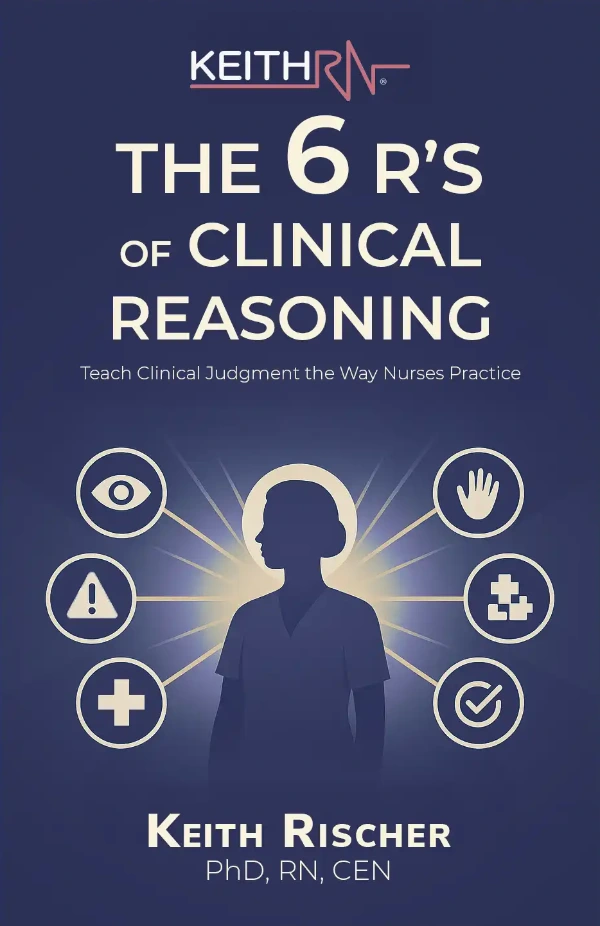
To graduate students who possess the clinical judgment required for safe practice and be prepared for the current and upcoming Next Gen NCLEX, they must know and UNDERSTAND essential content.
As an ED nurse who remains current in practice, I utilize the principle of triage every time I work.
I need to identify what is the ONE thing or PRIORITY task? Then I do that one thing next to provide safe patient care.
In the same way, if there is ONE thing that students must know about patho content to be safe and prepared for real-world practice, what do you think it would be?
To recognize a complication such as any shock state EARLY, students must be able to correctly and concisely state in their OWN words this simple yet profound formula:
CO=SVxHR
To illustrate the importance of this point, have students identify what the following three clinical scenarios have in common:
- June, a 52-year-old woman who is 6 hours post-op with a posterior spinal fusion. She is afebrile, but HR and BP pre-op were 78 and 132/80. Since her return to the surgical floor her HR has been consistently in the 100’s with a BP 100/60
- James, a 45-year-old man who presented to the ED intoxicated and just had a large coffee ground emesis. His HR is 110 and BP 80/40
- Jennifer, a 68-year-old woman who is post-op day #2 with a hemicolectomy due to a bowel obstruction. Her HR and BP pre-op were 90 and 110/82. She spiked a temp to 101.2 and HR is now 105 and BP 100/60
- John, a 68-year-old man admitted with heart failure exacerbation who has ischemic cardiomyopathy and an ejection fraction of 15%. His resting HR is consistently 90-100.
Why: CO=SVxHR?
Cardiac output is defined by the stroke volume or the amount of blood in the left ventricle with each contraction multiplied by the current heart rate. This is the measurement of the minute by minute cardiac output by the heart. 4-8 liters is normal to maintain adequate perfusion to the entire body.
Whenever cardiac output is decreased due to dehydration, heart failure, hypovolemia, or any shock state including sepsis, the FIRST and earliest compensatory response by the heart is to INCREASE the heart rate to maintain adequate cardiac output.
This is WHY an elevated heart rate without an obvious reason (elevated fever/severe pain) is always a clinical RED FLAG that must be recognized by the nurse. In early shock or hypovolemia, the HR will be elevated, but the BP will be normal or only slightly decreased.
If this early sign of decreased cardiac output goes unrecognized and begins to worsen, the problem will perpetuate and over time the blood pressure will begin to significantly drop to a shock state. By then it may be too late, and the patient may have an adverse outcome or even death as a result.
When CO=SVxHR is deeply understood by the student or new nurse, the clinical significance of an elevated HR and normal or dropping BP becomes readily apparent. The nursing and clinical priorities in each of these four scenarios become evident.
Scenarios Explained
Let’s apply this content to recognize the relevance and significance of each presentation:
- Why is there an elevation of heart rate with a lower BP? Though sepsis is possible,it is unlikely because of the short time frame after surgery and the temperature is normal. The most common and likely explanation early post-op is that the patient has a fluid volume deficit and is dehydrated. The nurse must recognize the significance of the clinical data collected and recognize the need to contact the primary care provider. The recommendation should include an IV bolus and reassess the response if successful (decreased HR and increased BP)
- In order to clinically reason, the nurse must recognize what clinical data is relevant. He is intoxicated with a coffee ground emesis. The clinical relationship of likely chronic alcohol abuse and a gastrointestinal bleed must be recognized. Combine this with a heart rate that is tachycardic and blood pressure that is too low captures the severity and crisis of an acute G.I. bleed that requires rapid intervention and rescue.
- In order to clinically reason, the nurse must recognize and identify the clinical trend or trajectory of clinical data collected. What direction is the TREND going? The temperature is rising and the heart rate is increasing and the blood pressure is decreasing slightly from the most recent. When the nurse deeply understands not only CO=SVxHR but the most likely complication of any invasive procedure is sepsis, the inflammatory response causing vasodilation resulting in decreased cardiac output. This patient is also in need of rapid rescue by the nurse!
- When the nurse knows that a normal ejection fraction is 60-70%, his strength of cardiac contraction is 1/4 that of a healthy heart. Since stroke volume is the other component in this equation, the elevated heart rate is most likely his baseline to maintain adequate CO with his end stage heart failure but the respiratory system must also be closely assessed for signs of pulmonary edema .
Why TMI Impacts Student Learning
When nurse educators expect students to know everything in a specific textbook chapter or lecture, students acquire a skin deep or superficial level of learning that will prevent them from acquiring the deep learning of what is truly most important.
When TMI prevails in a program, it adversely impacts student learning because novice nursing students see everything as EQUALLY relevant (Benner, 1982), and NEED to know content, such as deeply understanding CO=SVxHR and applying this to practice becomes just one more thing to memorize for the test.
It then becomes quickly lost in the shuffle with the next semesters worth of content that they are expected to know and is no longer is on the front burner to be consistently applied to practice as it should be.
Contextualize NEED to Know Content!
In order for students to acquire this salience or deep understanding of what is most important to clinical practice, it must be contextualized to the bedside (Benner, Sutphen, Leonard, & Day, 2010).
Resist the temptation to cover textbook knowledge abstractly. Situate to the bedside this essential formula of pathophysiology so students deeply understand it!
This is one of the reasons I wrote the student text THINK Like a Nurse, to not only help students understand clinical reasoning, but identify what content must be deeply understood to APPLY and USE in the clinical setting including CO=SVxHR!.
In Closing
It is the responsibility of nurse educators to prepare students for real-world clinical practice as well as highlight and emphasize what content is most important and needs to be applied to the bedside.
CO=SVxHR is one of these essential concepts of perfusion that must not only be taught but deeply understood by every nursing student before they leave your program.
Make it a priority to contextualize this essential concept to practice through clinical scenarios that you may see in your clinical setting or through scenarios that I have created in my clinical reasoning case studies.
By guiding students to deeply understand CO=SVxHR, you will not only prepare your students for the NCLEX®, but more importantly real-world clinical practice.
What do you think?
What content do you think is most important to clinical practice? How do you integrate it into your classroom and clinical settings?
Comment below and let the conversation begin!
References
- Benner, P. (1982). From novice to expert. American Journal of Nursing, 82(3), 402–407.
- Benner, P., Sutphen, M., Leonard, V., & Day, L. (2010). Educating nurses: A call for radical transformation. San Francisco, CA: Jossey-Bass.
Go Deeper…
I wrote THINK Like a Nurse: Practical Preparation for Professional Practice to put an exclamation point and highlight the essence of what is NEED to know content from nursing education including CO=SVxHR!.
Both students and nurse educators have found this resource helpful to deeply understand what is most important so it can be readily applied to the bedside!
Keith Rischer – PhD, RN, CEN
As a nurse with over 35 years of experience who remained in practice as an educator, I’ve witnessed the gap between how nursing is taught and how it is practiced, and I decided to do something about it! Read more…
The Ultimate Solution to Develop Clinical Judgment Skills
KeithRN’s Think Like a Nurse Membership
Access exclusive active learning resources for faculty and students, including KeithRN Case Studies, making it your go-to resource.




